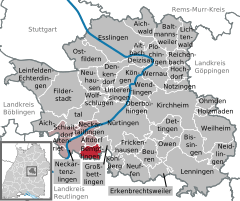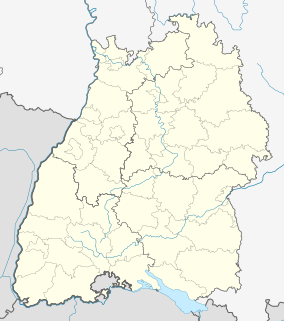Bempflingen
Bempflingen is a municipality in the district Esslingen in the Erms valley in Baden-Württemberg. It belongs to the Region Stuttgart and the European Metropolitan Region Stuttgart.
Bempflingen | |
|---|---|
 Coat of arms | |
Location of Bempflingen within Esslingen district   | |
 Bempflingen  Bempflingen | |
| Coordinates: 48°34′19″N 9°16′11″E | |
| Country | Germany |
| State | Baden-Württemberg |
| Admin. region | Stuttgart |
| District | Esslingen |
| Government | |
| • Mayor | Bernd Welser |
| Area | |
| • Total | 6.27 km2 (2.42 sq mi) |
| Elevation | 336 m (1,102 ft) |
| Population (2018-12-31)[1] | |
| • Total | 3,485 |
| • Density | 560/km2 (1,400/sq mi) |
| Time zone | CET/CEST (UTC+1/+2) |
| Postal codes | 72658 |
| Dialling codes | 07123 |
| Vehicle registration | ES |
| Website | www.bempflingen.de |
Geography
Geographical location
The municipal territory of Bempflingen covers a short section of the river valley of the Erms in the west and extends eastwards almost to the course of the Autmut river. The Eduard-Mörike-Hiking trail[2] and the Ermstal fruit cycle path[3]. South of the Reiner forest in direction Altdorf (Bempflinger Höhe) you can see the panorama of the Swabian Alb from the Hohenzollern over the Jusi to the three imperial mountains.
Neighboring communities
Adjoining communities are in turn Neckartenzlingen in the northwest, Altdorf in the north, Großbettlingen with a small settlement free exclave also in the north and with the main area in the northeast, all in district Esslingen; Grafenberg in the southeast, Riederich in the south as well as Reutlingen in the southwest, these in district Reutlingen.
Community Structure
Bempflingen consists of the two districts Bempflingen and Kleinbettlingen (Small bettlingen).
History

Bempflingen
Bempflingen was probably founded in the 5th century by Alemanni. This can also be concluded from the place name, which is probably connected with the first name Beonfil. At the place where the Alemannic row cemetery was found, a Roman manor house had previously stood.
Bempflingen was first mentioned in 1090, when the counts Kuno von Wülflingen and Liutold von Achalm and their nephew, count Werner von Grüningen signed the so-called Bempflinger Contract in Biemphelingin to settle the estate and especially to secure their foundation for Zwiefalten Monastery. At that time Bempflingen still belonged to the county Achalm.
Since the early 14th century the settlement belonged to the Kaib family. Later the village was sold and inherited by the Lords of Baustetten and the Lords of Mansberg. In 1448 Württemberg acquired the Baustettischen and in 1465 also the Mansberg part of the village. In 1639 Bempflingen and the Pfandschaft Achalm came under Austrian rule for ten years, but with the Peace of Westphalia came back to Württemberg. After the administrative reorganization at the beginning of the 19th century Bempflingen came to the Oberamt Urach, later to the Landkreis Nürtingen. The administrative reorganization of 1973 led to the affiliation to the administrative district Esslingen.
Religions
Bempflingen is since the Reformation protestant. But there is also a small catholic parish. The today's evangelical parish Bempflingen[5] comprises the main village and the suburb Kleinbettlingen and belongs to the church district Bad Urach-Münsingen of the evangelical regional church in Württemberg.
Population development
|
Politics
Mayors
- 1875–1909: Christian Seybold
- 1909–1927: Gottlob Doster
- 1927–1946: Otto Helber
- 1946: Gotthilf Hahn (Amtsverweser)
- 1946: Friedrich Frank (Amtsverweser)
- 1946–1966: Erwin Albrecht Reich
- 1966–1994: Helmut Kölle
- 1994–2010: Berndt Heidrich
- seit Februar 2010: Bernd Welser
In the mayoral election on 8 November 2009, Bernd Welser was elected in the first ballot with 87.72 % as successor to the incumbent mayor. The voter turnout was 66.29 %.
City council
In Bempflingen the local council is elected according to the procedure of the false partial place election. Thereby the number of local councils can change due to overhanging mandatee. The local council in Bempflingen has 14 members after the last election (2014: 15). The municipal elections on 26 May 2019 led to the following final result. The local council consists of the elected honorary local councillors and the mayor as chairman. The mayor is entitled to vote in the municipal council.
| Parties and electoral communities | % 2019 |
Seats 2019 |
% 2014 |
Seats 2014 |
rowspan="10" | |
| FWV | Freie Wählervereinigung Bempflingen | 50,24 | 7 | 50,03 | 7 | |
| SPD/UB | Sozialdemokratische Partei Deutschlands/Unabhängige Bürger | 36,00 | 5 | 44,15 | 7 | |
| Bürgerliste | Bürgerliste Bempflingen | 13,76 | 2 | 5,82 | 1 | |
| total | 100,0 | 14 | 100,0 | 15 | ||
| Voter participation | 62,3 % | 54,5 % | ||||
Crest
Blazoning: Under a double row of silver (white) and black chased shield head in blue a silver (white) diagonal bar, covered with three red arrowheads.
The coat of arms, with the blue shield and the silver slanting beam covered with three red arrowheads, refers to the former lords of the village, the lords of Baustetten, who owned three quarters of the village in the 15th century. The lords of Mannsberg, who also owned Bempflingen, are represented by the checkerboard pattern in the coat of arms.
The municipal flag has the colours red and white (red and silver). Flag and coat of arms were awarded to the municipality by the Ministry of the Interior in 1957.
Economy and Infrastructure
Traffic

Bempflingen is reached by the railway line Plochingen-Tübingen (Stuttgart-Horb am Neckar) to the supra-regional rail network. There are regional trains running at least every hour in the direction of Tübingen and Plochingen. During rush hour there is a stop of the Regionalexpresses Tübingen-Stuttgart, apart from that there is no more connection to Stuttgart without changing trains.
Coming from Nürtingen, Bempflingen is the last stop for which the VVS tariff applies. Until 2008 a DB ticket was still necessary to continue the journey to Metzingen; on January 1st 2009 Bempflingen was integrated into the naldo tariff, so that only a naldo ticket is necessary to continue the journey to Tübingen.[6]
Education
In Bempflingen there is the Grundschule "Auf Mauern" (On walls), the visit of secondary schools is possible in Neckartenzlingen, Metzingen or Nürtingen. There are also three kindergartens in Bempflingen, two of them (Hanflandweg and Auf Mauern) are located in the main village and one in Kleinbettlingen.
Buildings

- The foundation walls of today's "Bempflinger Mühle" date back to 1659 and the Erms Canal was built for the mill, which was first documented in 1391.
- The evangelic Stephanuschurch was built at the end of the 13th century as a replacement of an older predecessor building in late Romanesque style, of which the north wall and the lower part of the tower are still preserved in the present building. The nave was built in 1827 by the Stuttgart building surveyor Christian Friedrich Roth as Hall church in the Kameralamtsstil with a pulpit altar wall and a three-sided gallery. Chief building officer Christian Friedrich von Leins raised the tower in 1869 in neo-Romanesque style.[7] Architect Heinz Klatte arranged an interior renovation in 1954. Two bells from the years 1468 and 1514 are preserved.
- The schoolhouse was newly built in 1773.
Supply and disposal
Power supply
The electricity grid in the community is operated by FairNetz GmbH.[8]
Gas supply
The natural gas network is operated by FairEnergie GmbH, a subsidiary of Stadtwerke Reutlingen GmbH and EnBW.[9]
Water supply
The first public water supply was built in 1909. Today, the entire municipal area of Bempflingen and Kleinbettlingen is supplied with pure water from Lake Constance.
Sewage disposal
The Zweckverband Abwasserreinigung Bempflingen-Riederich operates a sewage treatment plant for the sewage disposal of the communities Bempflingen and Riederich.
Waste disposal
The waste management company of the district of Esslingen is responsible for waste disposal. There are separate collections for organic waste, household waste and paper.
References
- "Bevölkerung nach Nationalität und Geschlecht am 31. Dezember 2018". Statistisches Landesamt Baden-Württemberg (in German). July 2019.
- http://www.nuertingen.de/5302
- "meinKA | News, Events, Freizeit & Sport in Karlsruhe". meinKA. Archived from the original on 2020-05-13. Retrieved 2020-07-17.
- "Fläche seit 1996 nach tatsächlicher Nutzung - Statistisches Landesamt Baden-Württemberg". www.statistik-bw.de. Archived from the original on 2016-07-28. Retrieved 2020-07-17.
- "Bempflingen | Evang. Kirchenbezirk Bad Urach". www.kirchenbezirk-badurach-muensingen.de. February 14, 2018. Archived from the original on June 4, 2020. Retrieved July 17, 2020.
- "Archived copy". Archived from the original on 2008-09-30. Retrieved 2020-07-17.CS1 maint: archived copy as title (link)
- Eva-Maria Seng: The Protestant church building in the 19th century. The Eisenach Movement and the architect Christian Friedrich von Leins; Tübinger Studien zur Archäologie und Kunstgeschichte Volume 15, dissertation from 1992, published Tübingen 1995, Picture No. 428
- GmbH, Südwest Presse Online-Dienste (July 4, 2012). "Zuschlag für den kleineren Anbieter". swp.de.
- BDEW (eds.): Map of gas network operators 2012. Frankfurt 2012.
